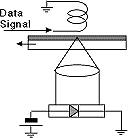 |
 |
A single MD holds the same amount of music as a CD (up to 80 minutes in "SP" recording mode) but does so in one fifth as many bits by using an audio compression method Sony calls ATRAC (Adaptive TRansform Acoustic Coding). ATRAC is a form of perceptual coding, a data reduction technique that attempts to encode only the information audible to the human perceptual system. Sony describes the details of their ATRAC system in an Audio Engineering Society technical report. A (translated) interview that appeared in MJ Audio Technology Magazine with the creators of Sony's top of the line MD-JA3ES deck also helps explain the MiniDisc signal compression technology. ATRAC is the basis of Sony's SDDS cinema digital audio system.
Perceptual coding, based upon the masking effect, is also the principle behind the MPEG, Dolby Labs AC-3, and Bell Labs PAC (Perceptual Audio Coding) compression algorithms.

Recordable MiniDiscs use a variation on conventional magneto- optical methods that Sony calls "Magnetic Field Modulation", in which data is recorded using a 4.5mW semiconductor laser together with a magnetic head. As the disc sweeps past the laser, a tiny area on the MD's magnetic recording layer is heated to its Curie temperature* while the field of the magnetic head in contact with the other side of the disc is switched back and forth to write a data pattern. When the area the head has magnetized moves away from the laser spot it cools below the Curie point to become cast in a string of N and S magnetized regions on the disc, spaced 60 millionths of a centimeter apart, and corresponding to the stream of bits being recorded.
Playback is accomplished using the same laser at about 1/10th power, and makes use of a phenomenon known as the Faraday effect in which a light beam's plane of polarization is rotated when it passes through a magnetic field. The readout laser beam is aimed at, and reflects from, the previously recorded magnetic regions; the optical pickup detects the polarization differences corresponding to beam reflection from N or S magnetized regions in order to reconstruct the recorded bit stream. (*The Curie temperature is the point at which a magnetic material loses coercivity, allowing it to be magnetized by a very weak field. For the MD recording layer [a compound of Terbium, Iron, and Cobalt], this temperature is 180°C).
MiniDisc manufacturing is an exacting process that involves the use of vacuum sputtering machines in a clean room environment. Interviews with Drs. Gassmann and Voser of Balzers Process Systems in Liechtenstein (which makes the Sprinter, Sprinter 750, and Multi Sprinter for MD manufacturing), and a page describing the BPS Sprinter machine give more details about the MD manufacturing process. Sony DADC's MiniDisc Handbook (in PDF format) gives a technical guide to pre-recorded MD production. Sony Disc Manufacturing's website has a good deal of technical information for artists producing MiniDiscs. The MiniDisc (and Compact Disc) substrate itself is made from a plastic called Makrolon, developed by Bayer in Germany. It is a surprisingly resilient material, try bending a CD sometime.
Sony describes the Magneto-Optical (MO) recording technology used for MDs in a technical paper on their HS MO system. Sony Singapore has some good diagrams explaining MD technology. Sony Japan also has some colorful, mildly technical MD coverage, as well as a simple MD technology animation for kids, in English. The 1394 (a.k.a Firwire) Trade Association documentation page contains information on the AV/C Disk Media Type Specification MD - audio (.PDF) with many technical details about the MD-clip format.